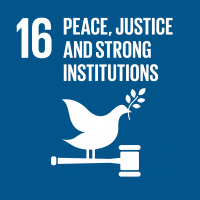
This project will advance the integration of positive peace and environmental sustainability in order to maximize the impact of their policies and initiatives in societies vulnerable to conflict and environmental risks. Global environmental changes are transforming the security landscape in which both conflicts and peacebuilding processes take place. While existing research underscores the importance of climate-sensitive approaches to peacebuilding, the focus has been on violent conflict and environmental degradation. The relationship between the positive dimension of peace and more local manifestations of environmental sustainability, however, remain grossly under-examined. This project, therefore, will identify the relationship between positive peace and sustainability by analyzing a panel data of existing national-level indicators drawn from the Institute for Economics & Peace’s Positive Peace Index and Yale University’s Environmental Performance Index. After examining the associations of the indices’ ranking and the relationship between their indicators, an integrated index that covers both positive peace and environmental sustainability will be created and linked to an annually updated database of existing relevant statistics. To complement the national data with local perspectives, this project will also undertake case studies of Nepal and Afghanistan, two countries that have ranked low in both indices in recent years. In these countries, a lack of environmental sustainability is observable in increased water scarcity and floods, which exacerbate social, economic, and political issues, contributing to community-level conflict and regional tensions. Integrating the components of positive peace and environmental sustainability using a mixed-methods, interdisciplinary research design enables a holistic approach to peace and sustainability.


Short-term (until March 2021)
- To identify the variables linking positive peace and environmental sustainability and establish their relationship
- To integrate positive peace indicators and environmental sustainability indicators
Medium-term (until March 2022)
- To examine local perspectives and community-level manifestations of positive peace- environmental sustainability nexus
- To influence research, policies, and initiatives on positive peace and environmental sustainability
Long-term (until March 2024)
- To advance end-user engagement with various stakeholders working on peace and sustainability
- To develop a Hiroshima University-based research cluster on positive peace-environmental sustainability nexus




- Simangan, Dahlia. 2023. Beyond Indices of Peace and Sustainability: Everyday Perspectives from Nepal. Peace Review (online first). https://doi.org/10.1080/10402659.2023.2243244
- Simangan, Dahlia, Srinjoy Bose, John Lee Candelaria, Florian Krampe, Shinji Kaneko. 2023. Positive peace and environmental sustainability: Local evidence from Afghanistan and Nepal. Environment and Security (online first). https://doi.org/10.1177/27538796231185677
- Simangan, Dahlia Chui Ying Lee, Ayyoob Sharifi, John Lee Candelaria, Shinji Kaneko. 2023. A global analysis of interactions between peace and environmental sustainability. Earth System Governance 14:100152. https://doi.org/10.1016/j.esg.2022.100152
- Simangan, Dahlia, Ayyoob Sharifi, and Shinji Kaneko. 2021. Positive Peace Pillars and Sustainability Dimensions: An Analytical Framework. International Studies Review 23(4): 188-1905. https://doi.org/10.1093/isr/viab054
- Sharifi, Ayyoob, Dahlia Simangan, and Shinji Kaneko. 2021. The literature landscape on peace-sustainability nexus: A scientometric analysis. Ambio 50: 661-678. https://doi.org/10.1007/s13280-020-01388-8
- Sharifi, Ayyoob and Dahlia Simangan. 2021. Environmental Sustainability: The Missing Pillar of Positive Peace. In Standish, Katerina, Heather Devere, Adan Suazo, and Rachel Rafferty (eds.) The Palgrave Handbook of Positive Peace. Singapore, Springer Nature.











You must be logged in to post a comment.